Staff profile
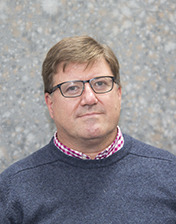
| Affiliation | Telephone |
|---|---|
| Professor in the Department of Physics | +44 (0) 191 33 43654 |
Biography
i) Recent Open Access Publications
Weakly-emergent strain-dependent properties of high field superconductors P Branch, Y Tsui, K Osamura and D P Hampshire. Nature Scientific Reports Volume 9, Article number: 13998 (2019)
A Derivation of Maxwell’s Equations using the Heaviside notation. D P Hampshire. Phil. Trans. Royal. Society. A 376: 20170447 (2018)
Patent: Superconducting Magnet for Producing Part of a Substantially Toroidal field. D P Hampshire, T S Lee and E Surrey. http://dro.dur.ac.uk/26302/ (2018)
ii) External Responsibilities
Chair (rolling) of the Institute of Physics, Fellow’s Appointing Committee – IOP Fellow’s Committee.
Member of the Executive Council of the British Cryogenics Council. – BCC.
Chairman of the International Programme Committee for the European Conference on Applied Superconductivity. EuCAS2019 - Glasgow 2019
Member of the International Programme Committee (Materials) for the European Conference on Applied Superconductivity. EuCAS2017 - Geneva 2017
Member of the International Advisory Committee for the International Conference on Superconductivity and Magnetism – ICMS2016, Fethiye, Turkey, April 2016.
Member of the International Advisory Committee Member for the Mechanical and Electromagnetic Properties of Composite Superconductors, - MEM16 Tallahassee, USA 2016.
iii) Responsibilities within department
Head of the Superconductivity Research Group and Director of the European Reference Laboratory for Fusion Energy
iv) Teaching activity
Supervisor for 4 PhD research projects. Lecture course responsibilities are: delivering lectures, setting homework problems, coordinating example classes, setting and marking examinations. 2nd year: Electromagnetism - Maxwell's equations (20 lectures for ~ 240 students, 36 Examples classes for ~ 60 students).
Research Highlights
i) Experimental [1], theoretical [2], computational evidence [3] and visualisation [4] that in polycrystalline materials, flux-flow is along channels (i.e. grain-boundaries in polycrystalline materials) that limit the critical current density (Jc) to less than 1% of the theoretical limit in high magnetic fields.
The scaling models of Kramer and Dew-Hughes, and latterly the collective pinning models of Matsushita, provided the description of pinning and Jc in technological high-field materials. The Durham group has demonstrated that at criticality, LTS and HTS materials have channels (that are grain boundaries in polycrystalline materials), along which fluxons flow when an electric field is generated. This has provided a straightforward explanation for why Jc is so much lower than the Ginzburg-Landau theoretical limit (i.e. JD) and has provided a framework for understanding and a range for improving Jc.
[1] P. Sunwong, J. S. Higgins, Y. Tsui, M. J. Raine and D. P. Hampshire - The critical current density of grain boundary channels in polycrystalline HTS and LTS superconductors in magnetic fields - SUST 26 095006 (2013). [2] Guanmei Wang, Mark J. Raine, and Damian P. Hampshire. How resistive must grain boundaries in polycrystalline superconductors be, to limit Jc? - SUST 20 104001 (2017) [2] G. J. Carty and D. P. Hampshire - The critical current density of an SNS Josephson-junction in high magnetic fields - SuST 26 065007 (2013) [3, 4] G. J. Carty and D. P. Hampshire - Visualising the mechanism that determines the critical current density in polycrystalline superconductors using time-dependent Ginzburg-Landau theory - Phys. Rev. B.77 (2008) 172501 also published in Virtual journal of applications of Superconductivity 15th May 2008 [4] Visualisation : http://community.dur.ac.uk/superconductivity.durham/fluxflow.html
ii) The design, in-house fabrication, development and operation of variable-temperature instruments for measuring, developing and understanding the strain-dependant critical current density of superconductors in magnetic fields in-house and at international high magnetic field facilities. Most recently in collaboration with Osamura, we have developed the multi-modal description of the strain dependence of Jc [1].
The original scaling laws used for optimisation of magnets for fusion applications were empirically based with the upper critical field as the scaling normalisation parameter. They lead to contradictions between so-called ‘strain-scaling’ and ‘temperature-scaling’ as found by Ekin. The group in Durham has published arguably the best variable-strain data of its type in the world. We developed a new scaling law (which replaced the Summer’s law) which resolved this contradiction. We introduced Ginzburg-Landau parameter kappa directly into the scaling law [2], develop the instrument that enabled comprehensive Jc(B,T,ε) measurements in fields up to Bc2 [3] that resolved temperature and strain scaling contradiction [4] and successfully combined phenomenological and microscopic theory to develop new scaling laws for strongly coupled superconductors such as Nb3Sn [5]. These new scaling laws have directly impacted on the design of the $50 B ITER fusion energy tokamak which will produce the world’s first self-sustaining fusion plasma. The DOE report - The future of science - considers ITER to be the world’s most important large scientific facility in the next 20 years [6].
[1] Kozo Osamura, Shutaro Machiya and Damian Hampshire. Mechanism for the uniaxial strain dependence of the critical current in practical REBCO tapes - SUST 29 065019 (2016)Paul Branch, Yeekin Tsui, Kozo Osamura and Damian P Hampshire Multimodal strain dependence of the critical parameters in high field technological superconductors submitted to SuST October 2017. [2] D. P. Hampshire and H. Jones - An in depth characterisation of a (NbTa)3Sn filamentary superconductor. IEEE Trans Magn Vol MAG-21 No. 2 289-292 (1985) [3] N. Cheggour and D. P. Hampshire - A probe for investigating the effects of temperature, strain, and magnetic field on transport critical currents in superconducting wires and tapes. Rev. Sci. Instr.714521-4530 (2000). [4] S A Keys, N Koizumi and D P Hampshire - The unified strain and temperature scaling law for the critical current density of a jelly-roll Nb3Al in high magnetic fields. Super. Sci. and Technol., 15991-1010 (2002)[5] D. M. J. Taylor and D. P. Hampshire - The scaling law for the strain-dependence of the critical current density in Nb3Sn superconducting wires - Supercond. Sci. Tech18(2005) S241-S252S. A Keys and D. P Hampshire - A scaling law for the critical current density of weakly and strongly-coupled superconductors, used to parameterise data from a technological Nb3Sn strand - Supercond. Sci. Technol.16(2003) 1097-1108[6] http://www.sciencemag.org/news/2003/11/fusion-computing-top-doe-wish-list
iii) The discovery of a new class of nanocrystalline materials where the high magnetic field properties are improved by making the length scales for the microstructure to be similar to the superconducting coherence length.
The process for making these materials has been patented [1] and then published in the premier Physics journals. The upper critical field in Chevrel phase superconducting materials was increased from 60 T (Tesla) to more than 100 T [2], in elemental niobium from ~ 1 T to ~ 3 T [3]. These materials have opened the opportunity of a new displacement technology for high field magnet conductors including say MRI magnets which is a $1 B annual market or fusion energy and opened a new area of fundamental and applied scientific investigation into nanocrystalline high-field materials.
[1] World-wide generic patent. Application No. 0210041.0 High field (nanocrystalline) superconductors Application completed April 02. Filed internationally in 2004. [2] H J Niu and D P Hampshire - Disordered Nanocrystalline Superconducting PbMo6S8with a Very Large Upper Critical Field. Phys. Rev. Lett 91027002 (2003) - also published in: Virtual Journal of Applications of Superconductivity, July 15, Vol. 5 2003 and Virtual Journal of Nanoscale Science & Technology, July 21, Vol 8 2003[3] D. M. J. Taylor, M. Al-Jawad and D. P. Hampshire - A new paradigm for fabricating bulk high-field superconductors- Supercond. Sci. Tech21(2008) 125006
iv) Development of the metrology for measuring large numbers of high-field superconducting strands for the $50 B fusion energy tokamak being built in France and the development of joints for the commercial exploitation of fusion energy [1,2]. Hampshire is Director of the European Reference Laboratory for Fusion Energy. Dr. Mark Raine is the manager of the Laboratory.
[1] Yeekin Tsui, Elizabeth Surrey and Damian Hampshire. Soldered Joints - An essential component of demountable HTS fusion magnets - SUST 29 075005 (2016) - Highlights of 2016 : SuST Highlights of 2016 [2] T. Lee, I. Jenkins, E. Surrey and D. P. Hampshire - Optimal design of a toroidal field magnet system and cost of electricity implications for a tokamak using high temperature superconductors Fusion Engineering and Design 98 (2015)DOI: 10.1016/j.fusengdes.2015.06.125
v) Patents. A number of PhD students from the group have become patent lawyers.
[1] Patent: Hampshire, Damian P., Lee T. S. and Surrey, E. (2018) 'Superconducting magnet for producing part of a substantially toroidal field.' - Open AccessIntellectual Property Office, London. Application number (1707392.5). Published 18thJuly 2018. [2] Nanocrystalline Superconductivity - An (expired) patent for the method of increasing Bc2in superconductor materials by fabricating them in nanocrystalline form : Hampshire-patent-document.pdf.
Research Activities
i) Experiments in high-magnetic fields:
Members of the superconductivity group in Durham have published a series of articles characterising how the critical current (i.e. the maximum current a superconductor can carry without loss) is affected by the magnetic field, temperature and strain on the superconductors. JC(B,T,ε) are used to develop a theoretical scaling law which successfully combines phenomenological and microscopic theory. This JC(B,T,ε) scaling law is used by the fusion energy community. We have a 15 Tesla Helmholtz-like split-pair horizontal superconducting magnet system which is unparalleled in the university sector world-wide. This opened the exciting opportunity of making JC(B,T,ε) measurements on anisotropic HTS superconductors materials - which is extremely valuable for developing our fundamental understanding and optimisation for new technological applications using HTS materials.
For the best experiments, we combine world-class commercially available equipment with probes that have been designed and built in-house. Commercial cryogenic equipment in-house includes two high-field magnet systems, a fully equipped PPMS system, a new high-pressure system and a He-3 system. The world-class high field facilities and instruments are supported by a number of specialist probes designed and built in-house for making strain, magnetic, resistive and optical measurements on superconductors. For example, theJC(B,T,ε) data were obtained using an instrument built in Durham for use in our 17 Tesla vertical magnet system and for use in international high-field facilities in Grenoble, France.
Experiments:
X. F. Lu, S. Pragnell and D. P. Hampshire - Small reversible axial-strain window for the critical current of a high performance Nb3Sn superconducting strand - Appl. Phys. Lett.91132512-3 (2007), also published in: Virtual Journal of Applications of Superconductivity, October 1st, Vol. 13(2007).
D. M. J. Taylor and Damian P. Hampshire - The scaling law for the strain-dependence of the critical current density in Nb3Sn superconducting wires - Supercond. Sci. Tech18(2005) S241-S252
Simon A Keys and Damian P Hampshire - A scaling law for the critical current density of weakly and strongly-coupled superconductors, used to parameterise data from a technological Nb3Sn strand - Supercond. Sci. Technol.16(2003) 1097-1108
N R Leigh and D P Hampshire - Deriving the Ginzburg-Landau parameter from heat capacity data on magnetic superconductors with Schottky anomalies. Phys. Rev. B. 68174508 (2003)
C. M. Friend and D. P. Hampshire - Critical current density of Bi2Sr2Ca1Cu2Oδmonocore and mutifilamentary wires from 4.2K up to Tcin high magnetic fields. Physica C258213-221 (1996).
D. N. Zheng, H. D. Ramsbottom, and D. P. Hampshire - Reversible and irreversible magnetisation of the Chevrel phase superconductor PbMo6S8. Phys Rev B 5212931-12938 (1995).
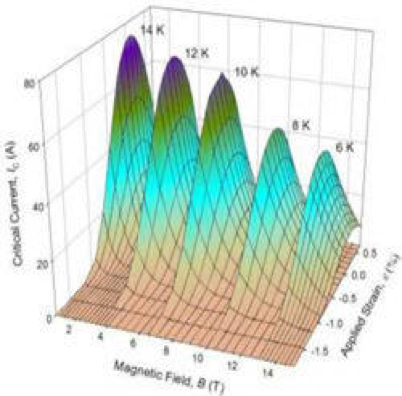
New Instruments:
Extract from the IoP journal: Superconductor Science and Technology. The critical current density as a function of field, temperature and uniaxial strain of a Nb3Al strand – measured in Durham
A. B. Sneary, C. M. Friend and D. P. Hampshire - Design, fabrication and performance of a 1.29 T Bi-2223 magnet. Super. Sci. and Technol.14433-443 (2001).
N. Cheggour and D. P. Hampshire - A probe for investigating the effects of temperature, strain, and magnetic field on transport critical currents in superconducting wires and tapes. Rev. Sci. Instr.714521-4530 (2000).
H. D. Ramsbottom and D. P. Hampshire - A Probe for measuring magnetic field profiles inside superconductors from 4.2K up to Tcin high magnetic fields. J. Meas. Sci. and Tech.61349-1355 (1995).
-
-
-
The world-class 15 Tesla horizontal/split-pair magnet: Durham Horizontal Split-Pair Magnet.pdfDurham Horizontal Split-Pair 40-37p5 Bore.pdfDurham Split-Pair Magnet Specs.doc
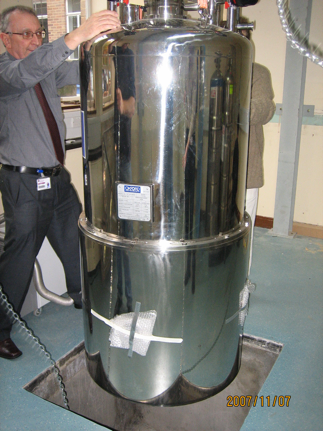
ii) Fabricating high-field nanocrystalline superconductors:
Members of the superconductivity group in Durham pioneered the discovery of a new class of nanocrystalline superconductivity materials with exceptionally good tolerance to high magnetic field. These materials provide a new paradigm for high-field conductors which has been patented and then published in the premier Physics journals. Equipment in-house includes DSC, DTA, XRD, glove box, a range of milling machines and furnaces as well a HIP operating at pressures of 2000 atmospheres and up to 2000 C. The upper critical field in Chevrel phase superconducting materials was increased from 60 T (Tesla) to more than 100 T and in elemental niobium from ~ 1 T to ~ 3 T. This work involves fundamental and applied scientific investigations into nanocrystalline high-field materials where the important length scales for superconductivity are similar to the length scales for the microstructure and is focussed on fabricating and understanding the physics of this new class of high magnetic field superconductors.
D. M. J. Taylor, M. Al-Jawad and D. P. Hampshire - A new paradigm for fabricating bulk high-field superconductors- Supercond. Sci. Tech21(2008) 125006
H J Niu and D P Hampshire - Disordered Nanocrystalline Superconducting PbMo6S8with a Very Large Upper Critical Field. Phys. Rev. Lett 91027002 (2003) - also published in: Virtual Journal of Applications of Superconductivity, July 15, Vol. 5 2003 and Virtual Journal of Nanoscale Science & Technology, July 21, Vol 8 2003
H J Niu and D P Hampshire - High Field Superconductors International Patent - Priority date 2nd May 2003

X-ray diffraction spectra and resistivity of conventional and noancrystalline niobium
iii) Empirical, computational and theoretical understanding of superconductors:
The boundaries between the best experiments, analysis and theoretical understanding and advanced computation are increasingly blurred. In addition to experimental work that includes advanced analysis, we have completed computation that provides the first reliable visualisation of how time-dependant-Ginzburg-Landau theory predicts flux moves in polycrystalline materials. This allows us to address why the critical current density in state-of-the-art commercial materials is still 3 orders of magnitude below the theoretical limit.
G. J. Carty and Damian P. Hampshire - Visualising the mechanism that determines the critical current density in polycrystalline superconductors using time-dependent Ginzburg-Landau theory - Phys. Rev. B
G. J. Carty and Damian P. Hampshire - Numerical studies on the effect of normal-metal coatings on the magnetization characteristics of type-II superconductors - Phys. Rev. B.71(2005) 144507 - also published in the May 1st, 2005 edition of the Virtual Journal of Applications of Superconductivity.
I. J. Daniel and D. P. Hampshire - Harmonic calculations and measurements of the irreversibility field using a vibrating sample magnetometer. Phys. Rev. B.616982-6993 (2000).
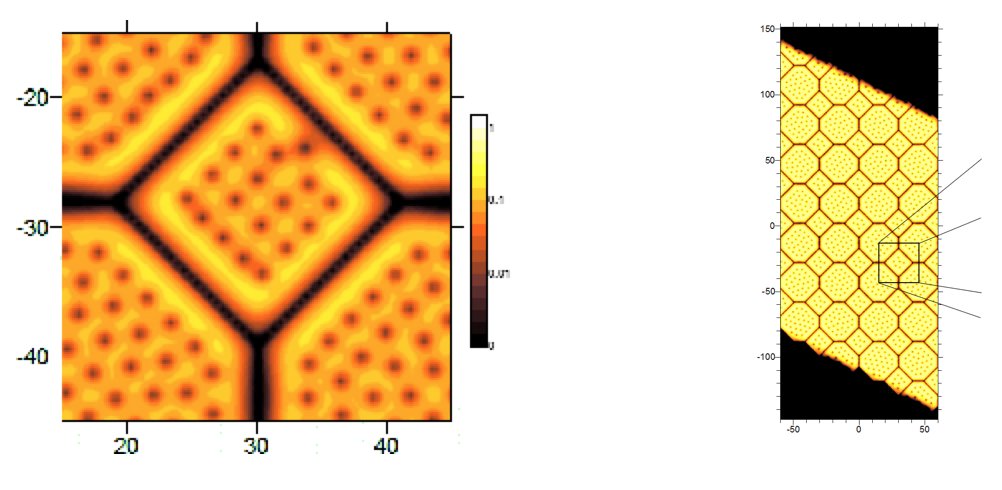
Flux flow: http://www.dur.ac.uk/superconductivity.durham/fluxflow.html
Industrial Themes:
i) The ITER fusion tokamak:
Superconductivity is the enabling technology for the $10B ITER (Fusion tokamak) project that the Department of Energy in the USA concluded is the most important large scale project in the world during the next 20 years. About one third of the cost is the superconducting magnets that will hold the burning plasma scheduled to ignite in 2018. The DOE in the USA concluded that ITER was the USA's first priority facility over the next 20 years: www.sc.doe.gov/Scientific_User_Facilities/20-Year-Outlook About one third of the cost is the superconducting magnets that hold the burning plasma. The first plasma is planned to ignite in 2018 http://www.physorg.com/news164558159.html The ITER project will be followed by the DEMO project that will provide 2 GW to the Japanese national grid The roadmap to magnetic confinement. The group has membership of the European magnet experts panel Durham Energy Institute: Fusion energy - science and technology
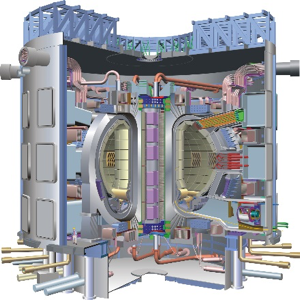
The ITER fusion reactor being built in Cadarache, France: http://www.iter.org/
ii) Energy:
Management of energy resources will be one of critical issues in the C21st. Superconductivity will have an important contribution to make to the development of new technologies. Durham university is ideally positioned to play a key role is this area.
Superconductors and power transmission.pdf
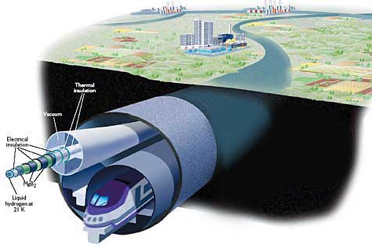
Superconducting power cables to reduce energy demand. http://www.amsc.com/index.html

Maglev in Japan: http://video.google.com/videoplay?docid=2926400396387878713
iii) High field magnets and MRI:
There is a industrial need for superconducting materials that carry higher critical current in high magnetic fields to reduce cost. Applications include high-field research magnetic for accelerators such as LHC and MRI medical body scanners where higher magnetic fields equate to better resolution.
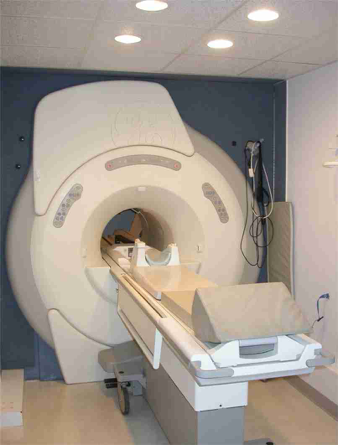
MRI body scanner – similar to the one found for example in the hospital in Durham, UK.
If you would like to apply to join the Superconductivity group go to: http://www.dur.ac.uk/superconductivity.durham/vacancies.html
Esteem Indicators
- 2000: aHead of the Superconductivity Research Group:
- 2000: cMember of the Executive Board of the British Cryogenics Council:
- 2000: eMember of the EPSRC (UK Government) peer review panel:
- 2000: g2006-2013: Editor-in-Chief of the IoP journal Superconductor Science and Technology:
- 2000: bChair (rolling) for IoP Fellows Appointing Committee:
- 2000: dDirector of the European Reference Laboratory for Fusion Energy:
- 2000: f 2019: Chair of EuCAS19 Glasgow Programme Committee(1000 attendees):
- 2000: h2010: Founding-Director of the Centre for Materials Physics:
Publications
Authored book
- Pusceddu, E., Charlton, S., & Hampshire, D. (2008). Nanocrystalline Nb-Al-Ge mixtures fabricated using wet mechanical milling. IOP Publishing. https://doi.org/10.1088/1742-6596/97/1/012241
- Xiang, J., Fleck, C., & Hampshire, D. (2008). Bulk nanocrystalline superconducting YBa2Cu3O7-x. IOP Publishing. https://doi.org/10.1088/1742-6596/97/1/012237
Chapter in book
Conference Paper
- Zheng, D., Sneary, A., & Hampshire, D. (1997). Critical current of Gd doped PbMo6S8 synthesised at 1500 degrees C.
- Cheggour, N., & Hampshire, D. (1997). The role of vortex melting and inhomogeneities in the transport properties of Nb3Sn superconducting wires.
- Daniel, I., Zheng, D., & Hampshire, D. (1997). An investigation of the peak effect in the chevrel phase superconductor tin molybdenum sulphide.
- Hamid, H., Zheng, D., & Hampshire, D. (1995). Transport critical current measurements of a HIP'ed and unHIP'ed bulksamples of PbMo6S8 in magnetic fields up to 12 Tesla.
- Zheng, D., & Hampshire, D. (1995). Critical currents of the Chevrel phase Pb1-xGdxMo6S8.
- Ramsbottom, H., & Hampshire, D. (1995). Critical current densities, scaling relations and flux pinning in NbTi as determined by flux penetration measurements.
- Ali, S., Ramsbottom, H., Zheng, D., & Hampshire, D. (1995). Specific heat of PbMo6S8 and (Pb0.7Gd0.3)Mo6S8 superconductors in high magnetic fields.
Journal Article
- Hutson, R., Raine, M., Kiuchi, M., Matsushita, T., & Hampshire, D. (2023). HTS Cable International Round Robin: 4.4 kA Critical Current Measurements. IEEE Transactions on Applied Superconductivity, 33(5), https://doi.org/10.1109/tasc.2023.3263143
- Gillard, E., Raine, M., & Hampshire, D. (2023). Resistivity Measurements of the Strain, Temperature and Angular Dependence of the Upper Critical Field of REBCO Tapes up to 8 T. IEEE Transactions on Applied Superconductivity, https://doi.org/10.1109/tasc.2023.3273198
- Haddon, C., Blair, A., Schoofs, F., & Hampshire, D. (2022). Computational Simulations Using Time-Dependent Ginzburg–Landau Theory for Nb–Ti-Like Microstructures. IEEE Transactions on Applied Superconductivity, 32(4), Article 8800105. https://doi.org/10.1109/tasc.2022.3156916
- Din, B., Blair, A., Schoofs, F., & Hampshire, D. (2022). Critical Current Densities through Josephson Junctions in Low Magnetic Fields. IEEE Transactions on Applied Superconductivity, 32(4), Article 8000805. https://doi.org/10.1109/tasc.2022.3156908
- Gurnham, C., & Hampshire, D. (2022). Self-Field Effects in a Josephson Junction Model for Jc in REBCO Tapes. IEEE Transactions on Applied Superconductivity, 32(4), Article 8000205. https://doi.org/10.1109/tasc.2021.3132858
- Blair, A., & Hampshire, D. (2022). Critical current density of superconducting-normal-superconducting Josephson junctions and polycrystalline superconductors in high magnetic fields. Physical Review Research, 4(2), Article 023123. https://doi.org/10.1103/physrevresearch.4.023123
- Pessoa, A., Raine, M., Hampshire, D., Namburi, D., Durrell, J., & Zadorosny, R. (2020). Successful production of solution blow spun YBCO+Ag complex ceramics. Ceramics International, 46(15), 24097-24101. https://doi.org/10.1016/j.ceramint.2020.06.188
- Branch, P., Osamura, K., & Hampshire, D. (2020). Weak emergence in the angular dependence of the critical current density of the high temperature superconductor coated conductor REBCO. Superconductor Science and Technology, 33(10), Article 104006. https://doi.org/10.1088/1361-6668/abaebe
- Chislett-Mcdonald, S., Tsui, Y., Surrey, E., Kovari, M., & Hampshire, D. (2020). The magnetic field, temperature, strain and angular dependence of the critical current density for Nb-Ti. Journal of Physics: Conference Series, 1559, Article 012063. https://doi.org/10.1088/1742-6596/1559/1/012063
- Gurnham, C., Große, V., & Hampshire, D. (2020). Angular Jc measurements at 77 K in-field, on an ISD REBCO coated conductor using a straightforward mechanical scribing technique to reduce tape width. Journal of Physics: Conference Series, 1559, Article 012036. https://doi.org/10.1088/1742-6596/1559/1/012036
- Branch, P., Tsui, Y., Osamura, K., & Hampshire, D. (2019). Weakly-Emergent Strain-Dependent Properties of High Field Superconductors. Scientific Reports, 9, Article 13998. https://doi.org/10.1038/s41598-019-50266-1
- Osamura, K., Machiya, S., Kajiwara, K., Kawasaki, T., Harjo, S., Zhang, Y., …Hampshire, D. P. (2019). Inverted-parabolic and weak strain dependencies on the critical current in practical and oriented REBCO tapes. AIP Advances, 9(7), Article 075216. https://doi.org/10.1063/1.5092248
- Hampshire, D. (2018). A derivation of Maxwell’s equations using the Heaviside notation. Philosophical Transactions of the Royal Society A: Mathematical, Physical and Engineering Sciences, 367(2134), Article 20170447. https://doi.org/10.1098/rsta.2017.0447
- Greenwood, J. R., Surrey, E., & Hampshire, D. P. (2018). Biaxial Strain Measurements of Jc on a (RE)BCO Coated Conductor. IEEE Transactions on Applied Superconductivity, 28(4), Article 8400705. https://doi.org/10.1109/tasc.2018.2793282
- Wang, G., Raine, M. J., & Hampshire, D. P. (2018). The Cause of ‘Weak-Link’ Grain Boundary Behaviour in Polycrystalline Bi2Sr2CaCu2O8 and Bi2Sr2Ca2Cu3O10 Superconductors. Superconductor Science and Technology, 31(2), Article 024001. https://doi.org/10.1088/1361-6668/aaa1b8
- Wang, G., Raine, M. J., & Hampshire, D. P. (2017). How Resistive Must Grain Boundaries in Polycrystalline Superconductors be, to Limit J_c?. Superconductor Science and Technology, 13(10), Article 104001. https://doi.org/10.1088/1361-6668/aa7f24
- Ridgeon, F., Raine, M., Halliday, D., Lakrimi, M., Thomas, A., & Hampshire, D. (2017). Superconducting Properties of Titanium alloys (Ti-64 and Ti-6242) for critical current barrels. IEEE Transactions on Applied Superconductivity, 27(4), Article 4201205. https://doi.org/10.1109/tasc.2016.2645378
- Tsui, Y., Surrey, E., & Hampshire, D. (2016). Soldered joints—an essential component of demountable high temperature superconducting fusion magnets. Superconductor Science and Technology, 29(7), Article 075005. https://doi.org/10.1088/0953-2048/29/7/075005
- Osamura, K., Machiya, S., & Hampshire, D. (2016). Mechanism for the uniaxial strain dependence of the critical current in practical REBCO tapes. Superconductor Science and Technology, 29(6), Article 065019. https://doi.org/10.1088/0953-2048/29/6/065019
- Ghoshal, P., Fair, R., Hampshire, D., Hagen-Gates, V., Kashy, D., Legg, R., …Tsui, Y. (2016). Design and Evaluation of Joint Resistance in SSC Rutherford-Type Cable Splices for Torus Magnet for the Jefferson Lab 12-GeV Upgrade. IEEE Transactions on Applied Superconductivity, 26(4), Article 4800304. https://doi.org/10.1109/tasc.2016.2517922
- Boutboul, T., Abaecherli, V., Berger, G., Hampshire, D., Parrell, J., Raine, M., …Zhang, Y. (2016). European Nb3Sn Superconducting Strand Production and Characterization for ITER TF Coil Conductor. IEEE Transactions on Applied Superconductivity, 26(4), Article 6000604. https://doi.org/10.1109/tasc.2015.2512386
- Tsui, Y., Mahmoud, R., Surrey, E., & Hampshire, D. (2016). Superconducting and Mechanical Properties of Low-Temperature Solders for Joints. IEEE Transactions on Applied Superconductivity, 26(3), Article 6900204. https://doi.org/10.1109/tasc.2016.2536806
- Hu, D., Ainslie, M., Raine, M., Hampshire, D., & Zou, J. (2016). Modelling and comparison of in-field critical current density anisotropy in high temperature superconducting (HTS) coated conductors. IEEE Transactions on Applied Superconductivity, 26(3), Article 6600906. https://doi.org/10.1109/tasc.2016.2521585
- Lee, T., Jenkins, I., Surrey, E., & Hampshire, D. (2015). Optimal design of a toroidal field magnet system and cost of electricity implications for a tokamak using high temperature superconductors. Fusion Engineering and Design, 98-99, 1072-1075. https://doi.org/10.1016/j.fusengdes.2015.06.125
- Hu, D., Ainslie, M., Rush, J., Durrell1, J., Zou, J., Raine, M., & Hampshire, D. (2015). temperature superconducting coil. Superconductor Science and Technology, 28(6), Article 065001. https://doi.org/10.1088/0953-2048/28/6/065011
- Osamura, K., Machiya, S., Hampshire, D., Toshinori, T., Shobu, T., Kajiwarta, K., …Fujikami, J. (2014). Uniaxial strain dependence of the critical current of Di-BSCCO tapes. Superconductor Science and Technology, 27(8), Article 085005. https://doi.org/10.1088/0953-2048/27/8/085005
- Sunwong, P., Higgins, J., & Hampshire, D. (2014). Probes for investigating the effect of magnetic field, field orientation, temperature and strain on the critical current density of anisotropic high-temperature superconducting tapes in a split-pair 15 T horizontal magnet. Review of Scientific Instruments, 85(6), https://doi.org/10.1063/1.4881235
- Sunwong, P., Higgins, J., Tsui, Y., Raine, M., & Hampshire, D. (2013). The critical current density of grain boundary channels in polycrystalline HTS and LTS superconductors in magnetic fields. Superconductor Science and Technology, 26(9), Article 095006. https://doi.org/10.1088/0953-2048/26/9/095006
- Carty, G., & Hampshire, D. (2013). The critical current density of an SNS Josephson-junction in high magnetic fields. Superconductor Science and Technology, 26(6), Article 065007. https://doi.org/10.1088/0953-2048/26/6/065007
- Sunwong, P., Higgins, J., & Hampshire, D. (2011). Angular, Temperature, and Strain Dependencies of the Critical Current of DI-BSCCO Tapes in High Magnetic Fields. IEEE Transactions on Applied Superconductivity, 21(3), 2840-2844. https://doi.org/10.1109/tasc.2010.2097573
- Higgins, J., & Hampshire, D. (2011). Critical Current Density of YBa2Cu3O7-delta Coated Conductors Under High Compression in High Fields. IEEE Transactions on Applied Superconductivity, 21(3), 3234-3237. https://doi.org/10.1109/tasc.2010.2092735
- Raine, M., & Hampshire, D. (2011). Characterization of the Low Temperature Superconductor Niobium Carbonitride. IEEE Transactions on Applied Superconductivity, 21(3), 3138-3141. https://doi.org/10.1109/tasc.2010.2095491
- Lu, X., & Hampshire, D. (2010). The field, temperature and strain dependence of the critical current density of a powder-in-tube Nb3Sn superconducting strand. Superconductor Science and Technology, 23(2), Article 025002. https://doi.org/10.1088/0953-2048/23/2/025002
- Armstrong, H., Halliday, D., & Hampshire, D. (2009). Photoluminescence of gold, copper and niobium as a function of temperature. Journal of Luminescence, 129(12), 1610-1614. https://doi.org/10.1016/j.jlumin.2009.04.022
- Lu, X., & Hampshire, D. (2009). The Magnetic Field, Temperature and Strain Dependence of the Critical Current of a Nb3Sn Strand Using a Six Free-Parameter Scaling Law. IEEE Transactions on Applied Superconductivity, 19(3), 2619-2623. https://doi.org/10.1109/tasc.2009.2018847
- Taylor, D., Al-Jawad, M., & Hampshire, D. (2008). A new paradigm for fabricating bulk high-field superconductors. Superconductor Science and Technology, 21(12), Article 125006. https://doi.org/10.1088/0953-2048/21/12/125006
- Lu, X., Taylor, D., & Hampshire, D. (2008). Critical current scaling laws for advanced Nb3Sn superconducting strands for fusion applications with six free parameters. Superconductor Science and Technology, 21(10), Article 105016. https://doi.org/10.1088/0953-2048/21/10/105016
- Carty, G., & Hampshire, D. (2008). Visualizing the mechanism that determines the critical current density in polycrystalline superconductors using time-dependent Ginzburg-Landau theory. Physical review B, 77(17), Article 172501. https://doi.org/10.1103/physrevb.77.172501
- Larbalestier, D., Osamura, K., & Hampshire, D. (2008). MEM07: The 5th annual workshop on mechanical and electromagnetic properties of composite superconductors (princeton, NJ, USA, 21-24 August 2007). Superconductor Science and Technology, 21(5),
- Lu, X., Pragnell, S., & Hampshire, D. (2007). Small reversible axial-strain window for the critical current of a high performance Nb3Sn superconducting strand. Applied Physics Letters, 91(13),
- Taylor, D., & Hampshire, D. (2005). The scaling law for the strain dependence of the critical current density in Nb3Sn superconducting wires. Superconductor Science and Technology, 18(12), S241-S252
- Osamura, K., & Hampshire, D. (2005). MEM05: The 3rd International Workshop on Mechano-Electromagnetic Properties of Composite Superconductors (Kyoto, Japan, 17-20 July 2005) - Preface. Superconductor Science and Technology, 18(12),
- Taylor, D., & Hampshire, D. (2005). Relationship between the n-value and critical current in Nb3Sn superconducting wires exhibiting intrinsic and extrinsic behaviour. Superconductor Science and Technology, 18(12), S297-S302
- Carty, G., Machida, M., & Hampshire, D. (2005). Numerical studies on the effect of normal-metal coatings on the magnetization characteristics of type-II superconductors. Physical review B, 71(14),
- Taylor, D., & Hampshire, D. (2005). Properties of helical springs used to measure the axial strain dependence of the critical current density in superconducting wires. Superconductor Science and Technology, 18(3), 356-368
- Zanino, R., Bagnasco, M., Dittrich, G., Fietz, W., Fillunger, H., Hampshire, D., …Zahn, G. (2004). T-cs tests and performance assessment of the ITER Toroidal Field ModelCoil (Phase II). IEEE Transactions on Applied Superconductivity, 14(2), 1519-1522
- Niu, H., & Hampshire, D. (2004). Critical parameters of disordered nanocrystalline superconducting Chevrel-phase PbMo6S8. Physical review B, 69(17),
- Taylor, D., & Hampshire, D. (2004). Effect of axial strain cycling on the critical current density andn-value of ITER niobium-tin wires. Physica C: Superconductivity and its Applications, 401(1-4), 40-46. https://doi.org/10.1016/j.physc.2003.09.009
- Leigh, N., & Hampshire, D. (2003). Deriving the Ginzburg-Landau parameter from heat-capacity data on magnetic superconductors with Schottky anomalies. Physical review B, 68(17),
- Osamura, K., Wada, H., Nyilas, A., & Hampshire, D. (2003). MEM03: The Second International Workshop on Mechano-Electromagnetic Properties of Composite Superconductors, Kyoto, Japan - Preface. Superconductor Science and Technology, 16(9),
- Keys, S., & Hampshire, D. (2003). A scaling law for the critical current density of weakly- and strongly-coupled superconductors, used to parameterize data from a technological Nb3Sn strand. Superconductor Science and Technology, 16(9), 1097-1108
- Niu, H., & Hampshire, D. (2003). Disordered nanocrystalline superconducting PbMo6S8 with a very large upper critical field. Physical Review Letters, 91(2),
- Taylor, D., Keys, S., & Hampshire, D. (2002). E-J characteristics and n-values of a niobium-tin superconducting wire as a function of magnetic field, temperature and strain. Physica C: Superconductivity and its Applications, 372, 1291-1294
- Niu, H., & Hampshire, D. (2002). Fabrication of nanocrystalline and amorphous Chevrel phase PbMo6S8 powder by ball milling. Physica C: Superconductivity and its Applications, 372, 1145-1147
- Keys, S., Koizumi, N., & Hampshire, D. (2002). The strain and temperature scaling law for the critical current density of a jelly-roll Nb3Al strand in high magnetic fields. Superconductor Science and Technology, 15(7), 991-1010
- Osamura, K., Sugano, M., Nyilas, A., Shin, H., Weijers, H., Hampshire, D., …Ogata, T. (2002). The tensile property of commercial Bi2223 tapes: a report on the international round-robin test. Superconductor Science and Technology, 15(6), 888-893
- Cheggour, N., & Hampshire, D. (2002). The unified strain and temperature scaling law for the pinning force density of bronze-route Nb3Sn wires in high magnetic fields. Cryogenics, 42(5), 299-309
- Wood, D., Greener, V., & Hampshire, D. (2002). Physics : oxygen drips upwards from superconductors. Nature, 415(6874), 860-860. https://doi.org/10.1038/415860a
- Taylor, D., Keys, S., & Hampshire, D. (2002). Reversible and irreversible effects of strain on the critical current density of a niobium-tin superconducting wire. Cryogenics, 42(2), 109-112
- Sneary, A., Friend, C., & Hampshire, D. (2001). Design, fabrication and performance of a 1.29 T Bi-2223 magnet. Superconductor Science and Technology, 14(7), 433-443. https://doi.org/10.1088/0953-2048/14/7/303
- Hampshire, D. (2001). The non-hexagonal flux-line lattice in superconductors. Journal of Physics: Condensed Matter, 13(27), 6095-6113. https://doi.org/10.1088/0953-8984/13/27/304
- Niu, H., Morley, N., & Hampshire, D. (2001). Chevrel phase (Pb1-xCu1.8x)Mo6S8 with a mixed structure and high critical parameters. IEEE Transactions on Applied Superconductivity, 11(1), 3619-3622
- Morley, N., Leigh, N., Niu, H., & Hampshire, D. (2001). High upper critical field in the Chevrel phase superconductor lead-molybdenum-sulphide doped with europium. IEEE Transactions on Applied Superconductivity, 11(1), 3599-3602
- Cheggour, N., & Hampshire, D. (2000). A probe for investigating the effects of temperature, strain, and magnetic field on transport critical currents in superconducting wires and tapes. Review of Scientific Instruments, 71(12), 4521-4530. https://doi.org/10.1063/1.1324734
- Daniel, I., & Hampshire, D. (2000). Harmonic calculations and measurements of the irreversibility field using a vibrating sample magnetometer. Physical review B, 61(10), 6982-6993
- Cheggour, N., & Hampshire, D. (1999). Unifying the strain and temperature scaling laws for the pinning force density in superconducting niobium-tin multifilamentary wires. Journal of Applied Physics, 86(1), 552-555
- Cheggour, N., & Hampshire, D. (1999). Variable-temperature transport critical currents of niobium-tin wires under strain in high magnetic fields. IEEE Transactions on Applied Superconductivity, 9(2), 2517-2520
- Leigh, N., Zheng, D., & Hampshire, D. (1999). The upper critical field of the Chevrel phase superconductor lead-molybdenum-sulphide doped with gadolinium. IEEE Transactions on Applied Superconductivity, 9(2), 1739-1742
- Keys, S., Cheggour, N., & Hampshire, D. (1999). The effect of hot isostatic pressing on the strain tolerance of the critical current density found in modified jelly roll Nb3Sn wires. IEEE Transactions on Applied Superconductivity, 9(2), 1447-1450
- Sneary, A., Friend, C., Vallier, J., & Hampshire, D. (1999). Critical current density of Bi-2223/Ag multifilamentary tapes from 4.2K up to 90K in magnetic fields up to 23T. IEEE Transactions on Applied Superconductivity, 9(2), 2585-2588
- Sneary, A., Friend, C., Richens, P., Jones, H., & Hampshire, D. (1999). Development of high temperature superconducting coils using Bi-2223/Ag tapes. IEEE Transactions on Applied Superconductivity, 9(2), 936-939
- Ramsbottom, H., & Hampshire, D. (1999). Flux penetration measurements and the harmonic magnetic response of hot isostatically pressed (Pb,Gd)Mo6S8. Journal of Applied Physics, 85(7), 3732-3739
- Hamid, H., & Hampshire, D. (1998). Critical current density of superconductors as a function of strain in high magnetic fields. Cryogenics, 38(10), 1007-1015
- Cheggour, N., Decroux, M., Fischer, O., & Hampshire, D. (1998). Irreversibility line and granularity in Chevrel phase superconducting wires. Journal of Applied Physics, 84(4), 2181-2183
- Hampshire, D. (1998). Ferromagnetic and antiferromagnetic superconductivity. Physica C: Superconductivity and its Applications, 304(1-2), 1-11. https://doi.org/10.1016/s0921-4534%2898%2900293-7
- Hampshire, D. (1998). A barrier to increasing the critical current density of bulk untextured polycrystalline superconductors in high magnetic fields. Physica C: Superconductivity and its Applications, 296(1-2), 153-166. https://doi.org/10.1016/s0921-4534%2897%2901832-7
- Zheng, D., Ali, S., Hamid, H., Eastell, C., Goringe, M., & Hampshire, D. (1997). The critical current of the Chevrel phase superconductor lead-molybdenum-sulphur with gadolinium. Physica C: Superconductivity and its Applications, 291(1-2), 49-58
- Hampshire, D. (1997). Critical currents and the critical state in superconductors with magnetic ions. Physica C: Superconductivity and its Applications, 280(4), 269-271. https://doi.org/10.1016/s0921-4534%2897%2900294-3
- Zheng, D., & Hampshire, D. (1997). The effect of Gd doping on the critical current of the Chevrel phase superconductor PbMo6S8. IEEE Transactions on Applied Superconductivity, 7(2), 1755-1758
- Richens, P., Jones, H., VanCleemput, M., & Hampshire, D. (1997). Strain dependence of critical currents in commercial high temperature superconductors. IEEE Transactions on Applied Superconductivity, 7(2), 1315-1318
- Ramsbottom, H., & Hampshire, D. (1997). Harmonic flux penetration of superconductors in low-frequency, high-amplitude, alternating-current magnetic fields. Journal of Physics: Condensed Matter, 9(21), 4437-4453
- Hampshire, D. (1997). Magnetic properties of the flux line lattice in paramagnetic superconductors. Journal of Physics: Condensed Matter, 9(10), 2239-2258
- Ramsbottom, H., & Hampshire, D. (1997). Improved critical current density and irreversibility line in HIP'ed Chevrel phase superconductor PbMo6S8. Physica C: Superconductivity and its Applications, 274(3-4), 295-303
- Osamura, K., Nonaka, S., Matsui, M., Oku, T., Ochiai, S., & Hampshire, D. (1996). Factors suppressing transport critical current in Ag/Bi2223 tapes. Journal of Applied Physics, 79(10), 7877-7882. https://doi.org/10.1063/1.362398
- Friend, C., Tenbrink, J., & Hampshire, D. (1996). Critical current density of Bi2Sr2Ca1Cu2O delta monocore and multifilamentary wires from 4.2 K up to Tc in high magnetic fields. Physica C: Superconductivity and its Applications, 258(3-4), 213-221
- Ramsbottom, H., Ali, S., & Hampshire, D. (1996). Response of a new ceramic-oxynitride (Cernox) resistance temperaturesensor in high magnetic fields. Cryogenics, 36(1), 61-63
- Zheng, D., Ramsbottom, H., & Hampshire, D. (1995). Reversible and irreversible magnetization of the Chevrel-phase superconductor PBMO6S8. Physical review B, 52(17), 12931-12938
- Friend, C., & Hampshire, D. (1995). DIRECT EVIDENCE FOR A CHANGE AT 50 K IN THE CRITICAL-CURRENT PROPERTIES OF A BI2-XPBXSR2CA2CU3O-DELTA TAPE IN HIGH MAGNETIC-FIELDS. Physica C: Superconductivity and its Applications, 252(1-2), 107-116
- Friend, C., & Hampshire, D. (1995). ANOMALOUS BEHAVIOR IN THE CRITICAL-CURRENT DENSITY OF A (BI-2-X,PB-X)SR2CA2CU3O10-DELTA TAPE BELOW 10 K. Journal of Physics: Condensed Matter, 7(39), 7709-7715
- Ramsbottom, H., & Hampshire, D. (1995). A probe for measuring magnetic-field profiles inside superconductors from 4.2 K to Tc in high magnetic fields. Measurement Science and Technology, 6(9), 1349-1355
- Ramsbottom, H., Zheng, D., & Hampshire, D. (1995). AC MAGNETIZATION MEASUREMENTS ON HOT ISOSTATICALLY PRESSED BULK PBMO6S8FROM 4.2 KELVIN UP TO T-C IN HIGH MAGNETIC-FIELDS. IEEE Transactions on Applied Superconductivity, 5(2), 1321-1324. https://doi.org/10.1109/77.402806
- Friend, C., & Hampshire, D. (1995). A PROBE FOR THE MEASUREMENT OF THE TRANSPORT CRITICAL-CURRENT DENSITY OF SUPERCONDUCTORS IN HIGH MAGNETIC-FIELDS AND AT TEMPERATURES BETWEEN 2-K AND 150-K. Measurement Science and Technology, 6(1), 98-106
- Lelay, L., Friend, C., Maruyama, T., Osamura, K., & Hampshire, D. (1994). EVIDENCE THAT PAIR-BREAKING AT THE GRAIN-BOUNDARIES OF BI2SR2CA2CU3OX TAPES DETERMINES THE CRITICAL-CURRENT DENSITY ABOVE 10-K IN HIGH MAGNETIC-FIELDS. Journal of Physics: Condensed Matter, 6(46), 10053-10066
- Hampshire, D., & Chan, S. (1992). THE CRITICAL CURRENT-DENSITY IN HIGH FIELDS IN EPITAXIAL THIN-FILMS OF Y1BA2CU3O7-DELTA - FLUX PINNING AND PAIR BREAKING. Journal of Applied Physics, 72(9), 4220-4226
- Gray, K., Kampwirth, R., Miller, D., Murduck, J., Hampshire, D., Herzog, R., & Weber, H. (1991). OBSERVATION OF THE CROSSOVER BETWEEN BULK FLUX PINNING AND JOSEPHSON PHASE SLIPS IN THE CRITICAL CURRENT OF ANTIGRANULOCYTES SUPERCONDUCTING NBN ALN MULTILAYER FILMS. Physica C: Superconductivity and its Applications, 174(4-6), 340-344
- Hampshire, D., Oh, S., Osamura, K., & Larbalestier, D. (1990). TEMPERATURE-DEPENDENT CRITICAL CURRENT-DENSITY OF BI(PB)-SR-CA-CU-O TAPES IN FIELDS UP TO 20 TESLA. Superconductor Science and Technology, 3(11), 560-563
- Hampshire, D., Ikeda, J., & Chiang, Y. (1989). SCALING LAW AND FLUX PINNING IN POLYCRYSTALLINE LA1.85SR0.15CUO4. Physical review B, 40(13), 8818-8827
- Hampshire, D., Clark, A., & Jones, H. (1989). FLUX PINNING AND SCALING LAWS FOR SUPERCONDUCTING V3GA. Journal of Applied Physics, 66(7), 3160-3167
- Hampshire, D., & Larbalestier, D. (1989). THE CRITICAL CURRENT OF NBTI MULTIFILAMENTARY WIRE - A COMPARISON BETWEEN CRITICAL CURRENT DENSITIES DETERMINED USING AC MAGNETIZATION TECHNIQUES (JCM) AND DC TRANSPORT MEASUREMENTS (JCT) THROUGHOUT THE SUPERCONDUCTING PHASE. IEEE Transactions on Magnetics, 25(2), 1956-1959
- Hampshire, D., & Larbalestier, D. (1989). THE CRITICAL DENSITY THROUGHOUT THE SUPERCONDUCTING PHASE OF MULTIFILAMENTARY NB3SN WIRE FOR FORCED FLOW FUSION APPLICATIONS MEASURED USING THE BEAN-CAMPBELL AC MAGNETIZATION TECHNIQUE. IEEE Transactions on Magnetics, 25(2), 2382-2385
- Hampshire, D., Seuntjens, J., Cooley, L., & Larbalestier, D. (1988). ANOMALOUS SUPPRESSION OF TRANSPORT CRITICAL CURRENT BELOW BC2(T) INORIENTED SINTERED SAMPLES OF DYBA2CU3O7. Applied Physics Letters, 53(9), 814-815
- Larbalestier, D., Babcock, S., Cai, X., Daeumling, M., Hampshire, D., Kelly, T., …Seuntjens, J. (1988). WEAK LINKS AND THE POOR TRANSPORT CRITICAL CURRENTS OF THE 123 COMPOUNDS. Physica C: Superconductivity and its Applications, 153, 1580-1585
- Hampshire, D., Cai, X., Seuntjens, J., & Larbalestier, D. (1988). IMPROVED CRITICAL CURRENT CHARACTERISTICS IN 1-2-3 OXIDE SUPERCONDUCTORS - WEAK FLUX PINNING AND PERCOLATIVE ASPECTS. Superconductor Science and Technology, 1(1), 12-19
- Hampshire, D., & Jones, H. (1988). FLUX FLOW IN HIGH-TEMPERATURE TYPE-II SUPERCONDUCTORS GOVERNED BY THE ACTIVATION OF FRANK READ SOURCES AND THE RESULTANT MOTION OF CORE DISLOCATIONS. Journal of physics. C. Solid state physics, 21(2), 419-427
- Hampshire, D., & Jones, H. (1987). ANALYSIS OF THE GENERAL STRUCTURE OF THE E-I CHARACTERISTIC OF HIGH-CURRENT SUPERCONDUCTORS WITH PARTICULAR REFERENCE TO A NB-TI SRM WIRE. Cryogenics, 27(11), 608-616
- Larbalestier, D., Daeumling, M., Cai, X., Seuntjens, J., Mckinnell, J., Hampshire, D., …Joynt, R. (1987). EXPERIMENTS CONCERNING THE CONNECTIVE NATURE OF SUPERCONDUCTIVITY IN YBA2CU3O7. Journal of Applied Physics, 62(8), 3308-3313
- Hampshire, D., & Jones, H. (1987). A DETAILED INVESTIGATION OF THE E-J CHARACTERISTIC AND THE ROLE OF DEFECT MOTION WITHIN THE FLUX-LINE LATTICE FOR HIGH-CURRENT-DENSITY, HIGH-FIELD SUPERCONDUCTING COMPOUNDS WITH PARTICULAR REFERENCE TO DATA ON NBSSN THROUGHOUT ITS ENTIRE FIELD TEMPERATURE PHASE-SPACE. Journal of physics. C. Solid state physics, 20(23), 3533-3552
- Hampshire, D., & Jones, H. (1987). A NEW APPARATUS FOR MEASURING THE CRITICAL CURRENTS OF HARD TYPE-II SUPERCONDUCTIVE WIRES AND TAPES IN HIGH FIELDS AS A FUNCTION OF TEMPERATURE THROUGHOUT THEIR SUPERCONDUCTING PHASE. Journal of physics. E, Scientific instruments, 20(5), 516-520
- Hampshire, D., & Jones, H. (1987). THE DETAILED INVESTIGATION OF THE CRITICAL CURRENT-DENSITY OF OPTIMIZED NB3SN MODIFIED JELLY ROLL WIRE THROUGHOUT ITS ENTIRE SUPERCONDUCTING PHASE INCLUDING A COMPARATIVE-STUDY WITH A SIMILAR NON-OPTIMIZED COMPOSITE. physica status solidi (b) – basic solid state physics, 141(1), 229-237
- Somerkoski, J., Hampshire, D., Jones, H., Toivanen, R., & Lindroos, V. (1987). STRUCTURE AND SUPERCONDUCTING PROPERTY CHARACTERIZATION OF MF CU/NB-46.5 W-PERCENT TI SUPERCONDUCTORS. IEEE Transactions on Magnetics, 23(2), 1629-1633
- Hampshire, D., Jones, H., & Mitchell, E. (1985). AN IN DEPTH CHARACTERIZATION OF (NBTA)3SN FILAMENTARY SUPERCONDUCTOR. IEEE Transactions on Magnetics, 21(2), 289-292
Patent

